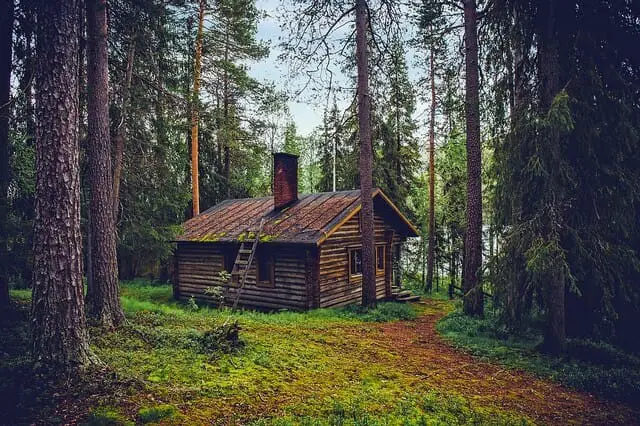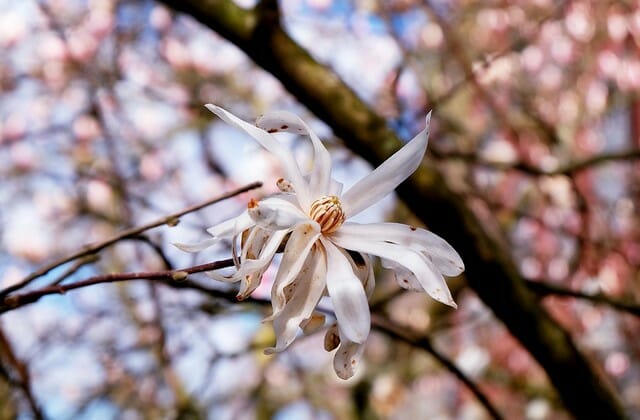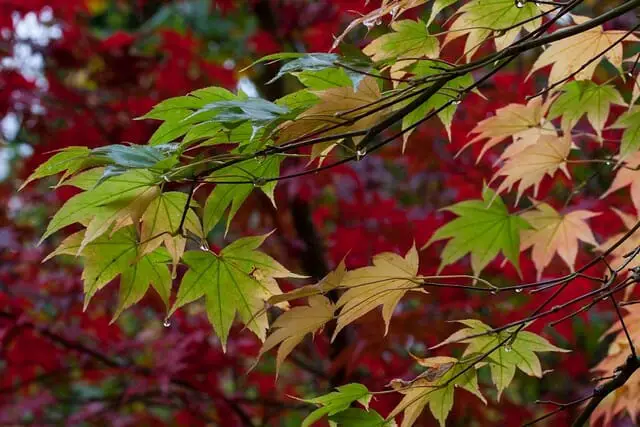Last Updated on January 13, 2022 by Grow with Bovees
Whether you want some privacy, a better landscape around you or just want to make the world a better place, planting a tree sure does have its benefits (and ones apart from those that we study in environmental education).
For instance, a mature tree can add anywhere between $1,000 and $10,000 to your real estate market value, which is a nice raise.
Additionally, a tree in the right spot can create shade, potentially saving you as much as 56% of your air-conditioning bill per year.

However, a tree is a long-term decision—from sapling to full-grown tree can take decades and left to Mother Nature’s will, these trees can remain where they’re planted for just as many decades and even centuries!
Therefore, if you’re planting a fast growing shade tree near your house, you may want to take into consideration factors such as messy fruit, shedding, invading tree roots, and the like, to save yourself decades of trouble.
So what trees are the best to plant near your house? We take a look at the different types, while also considering factors that you should bear in mind while picking out a tree!
How Do I Pick a Tree To Plant Near A House?
Asking yourself why you want to plant a tree goes a long way in helping you figure out which tree to choose. Are you looking for privacy, shade, to block out an unsavory view, or to spruce up your backyard?
If you’re looking for privacy, for example, you may want to pick a tree that’s inexpensive and grows fast, especially if you want your privacy ASAP!
You could just opt for a mature tree, but these are expensive, and they only get more expensive the slower their growth cycle is.
While a young tree is inexpensive, it can take years for it to give you the kind of barrier that you want. And if you want year-round privacy, you need to pick a tree that is in full bloom throughout the year, such as evergreen trees and not deciduous trees!

Similarly, if you’re looking for shade and want it quickly, choose a fast-growing tree. Hardwood trees grow slowly but last longer. If you want flowers quickly, choose a tree that flowers quickly—generally, smaller softwood trees that don’t have a very long life.
If you want a tree to spruce up your backyard ornamental trees are a good idea. It’s also a good idea to stick to native trees, as this means lesser maintenance, especially in the sapling and early-years phase.
If you do want to get a non-native tree for your house, check its compatibility with the current conditions in your region. You may want to see which ones are more tolerant to cold, which ones do well in acidic soil or which ones in moist, rich soil, or which ones in alkaline soil. Forsythia roots are not known to be invasive, and they can add a nice bit of color to your property.
The size of the space also matters. For smaller yards and houses, medium or small-sized trees will provide more beauty. Smaller trees can also be planted closer to the house and taller ones near the edge or beyond.
Some trees are more tolerant of pollution, so do better in city and urban conditions, weathering all the pollution, dust, nutrient-poor soil, salt sprays, inadequate and inefficient drainage, night lights and the like. However, these trees have shorter lives than their country cousins.

Remember, every rose has its thorn—we literally mean this as some trees can have thorns that could hurt children and pets. Some others are messy and some weedy, so consider these factors before you pick a tree variety!
How Near or Far Should the Tree Be?
The answer to this depends on the tree’s size—larger trees have wider root systems. However, a good rule is to plant them at least 8 to 10 feet away from your house and scale this figure as the tree’s height and spread increase.
Trees to Plant
‘Majestic Beauty’ Olive
First on the list is the ‘Majestic Beauty’ Olive, a tree with nearly no mature fruit—ergo, lesser debris than other members of the olive family. The tree features strong branches and evergreen, small, gray-green leaves—a distinguishing factor—and can grow to be at least 30 feet tall and wide. These trees thrive in moist or dry soil of any texture, making them low-maintenance trees to have around.
Dr. Hurd Manzanita
Manzanita trees feature glossy, oval-shaped, light green leaves and smooth, red bark. These evergreen trees can reach 15-20 feet (6.1 m) in height and grow well in both full sunshine and partial shade. Like the ‘Majestic Beauty’, they can do well in dry and moist soil, regardless of the texture. The branches are strong and there are no health hazards or possible tree root problems from these trees.
Weeping Willow
A weeping willow is a large tree that can grow to be more than 20 feet (6.1 m) tall. It can be an attractive addition to your backyard if you have the right conditions for it, and the right space for it. Because weeping willows are fast growers, they’re often used to provide quick shade in areas that need it, although they’re not a good choice for a windy area.
Black Cherry Plum
Black cherry plum trees hit two birds with one stone—they afford you great privacy and look pretty as a picture while doing so! These trees have lovely blossoms and gorgeously-colored leaves and are a sight to behold in the spring season!
Chanticleer
The tear-drop body of this tree makes them a pleasing sight for the eyes, while also determining how much light they can block. Some people dub these ‘the perfect street trees’ and they’re easy to grow, low-maintenance, and tolerate air pollution and heavy winds. These trees have gorgeous white blossoms come Spring and a lovely hue come autumn.
Star Magnolia
Star Magnolias have a lovely fragrance thanks to their flowers, with low-growing branches that become prominent once the tree sheds in winter. Star Magnolias can grow in partial shade and full sunlight, reaching heights of 10 feet (3.05 m) and widths of 12 feet (3.66 meters). These can grow in any type of soil—sandy, clayey or loamy—and have decently strong branches. The potential damage from roots is also quite low.

‘Elfin King’ Madrones
Also called—somewhat less fancily—strawberry tree, ‘Elfin King’ Madrones are dwarves, with an attractive reddish-brown bark that flakes easily, lovely little pink or white flowers that grow from fall till winter, and evergreen nature. These trees grow anywhere between 6 feet (1.83 m) and 12 feet (3.66 m) tall, in full and partial shade. They’re also drought-tolerant and do well in all types of soil.
Other Trees
Some other low-maintenance trees with less debris and non-invasive roots that you can consider include:
- Crab apple, a vase shaped tree growing up to 20 feet (6.1 m) in height, a great flowering tree
- Cornelian cherry dogwood trees whose flowers are a sight to behold
- Japanese maple trees, with their scarlet-colored leaves

- American hornbeams are small, slow-growing members of the birch family
- American hollies that are evergreen and low maintenance
- Flowering dogwood trees, with their delicate flowers and their ability to elevate the space around any wall
Trees Not To Plant Near Your Home
Oak Trees
From the mighty red oak to the fragrant white oak, oaks are beautiful and strong, growing in U.S forests and backyards across the country. While common oak trees are found throughout the country, there are actually over 300 types of oak trees in the world. The characteristics that make oak trees so resilient are the same that make them a favorite among homeowners.
The oak tree’s wood is one of the strongest and most durable, and all parts of the tree are useful to humans. Oak wood is great for building, and the acorns that fall from oak trees are edible, and can be used for anything from making flour for baking, to a tasty snack enjoyed by squirrels.
Oak Tree Roots
The roots of oak trees are extremely tough. They are fibrous and have an aggressive downward growing system that often extends ten feet in length.
They are able to cause foundational damage, as well as damage to sewer lines etc. The roots of the oak tree are spreading. In fact, some species of oaks can grow 2-3 feet (0.91 m) per year.
This is sometimes not ideal when planting trees in your yard.
It is important to consider the width of the oak tree roots when planting your tree. The oak tree roots are very much like a small tree. If you are going to plant the oak tree in your yard, it is important to consider how large the oak tree roots will be later in life.
Manitoba maple tree
It is not advisable to plant a manitoba maple tree close to your house, as they grow quite fast, and are prone to toppling over.
The Bottom Line
You know what they say about trees and the best time to have planted them, so any tree is a good tree to be planted, especially right now! Most trees can, in general, give you what you’re looking for, from fresh air to shade to privacy, so while you can have your preferences, don’t let them become the priority, over planting a tree.
Two’s company and tree’s definitely not a crowd, so whether it’s sprucing up your yard or increasing your real estate value or just enjoying a tree in all its abundant natural glory, now you know some of the best trees to plant near a house, go ahead and plant a tree today!
